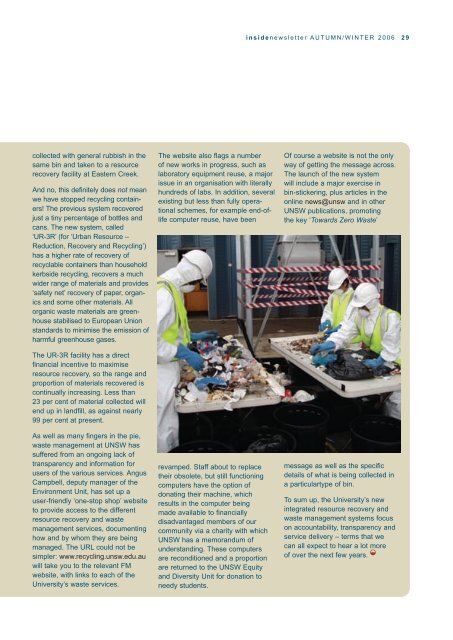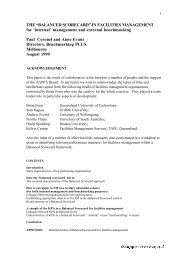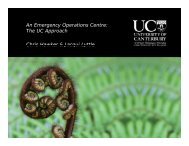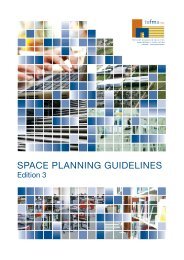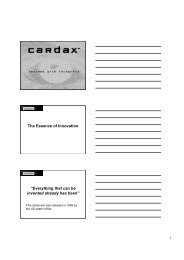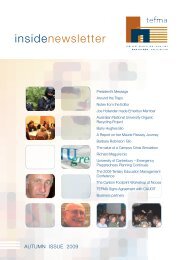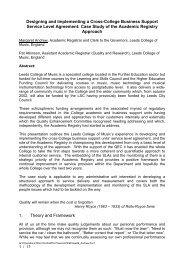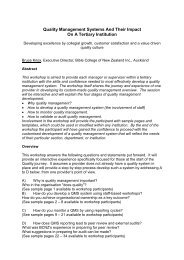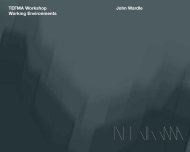insidenewsletter - Tertiary Education Facilities Management ...
insidenewsletter - Tertiary Education Facilities Management ...
insidenewsletter - Tertiary Education Facilities Management ...
Create successful ePaper yourself
Turn your PDF publications into a flip-book with our unique Google optimized e-Paper software.
<strong>insidenewsletter</strong> AUTUMN/WINTER 2006 29<br />
collected with general rubbish in the<br />
same bin and taken to a resource<br />
recovery facility at Eastern Creek.<br />
And no, this definitely does not mean<br />
we have stopped recycling containers!<br />
The previous system recovered<br />
just a tiny percentage of bottles and<br />
cans. The new system, called<br />
‘UR-3R’ (for ‘Urban Resource –<br />
Reduction, Recovery and Recycling’)<br />
has a higher rate of recovery of<br />
recyclable containers than household<br />
kerbside recycling, recovers a much<br />
wider range of materials and provides<br />
‘safety net’ recovery of paper, organics<br />
and some other materials. All<br />
organic waste materials are greenhouse<br />
stabilised to European Union<br />
standards to minimise the emission of<br />
harmful greenhouse gases.<br />
The UR-3R facility has a direct<br />
financial incentive to maximise<br />
resource recovery, so the range and<br />
proportion of materials recovered is<br />
continually increasing. Less than<br />
23 per cent of material collected will<br />
end up in landfill, as against nearly<br />
99 per cent at present.<br />
As well as many fingers in the pie,<br />
waste management at UNSW has<br />
suffered from an ongoing lack of<br />
transparency and information for<br />
users of the various services. Angus<br />
Campbell, deputy manager of the<br />
Environment Unit, has set up a<br />
user-friendly ‘one-stop shop’ website<br />
to provide access to the different<br />
resource recovery and waste<br />
management services, documenting<br />
how and by whom they are being<br />
managed. The URL could not be<br />
simpler: www.recycling.unsw.edu.au<br />
will take you to the relevant FM<br />
website, with links to each of the<br />
University’s waste services.<br />
The website also flags a number<br />
of new works in progress, such as<br />
laboratory equipment reuse, a major<br />
issue in an organisation with literally<br />
hundreds of labs. In addition, several<br />
existing but less than fully operational<br />
schemes, for example end-oflife<br />
computer reuse, have been<br />
revamped. Staff about to replace<br />
their obsolete, but still functioning<br />
computers have the option of<br />
donating their machine, which<br />
results in the computer being<br />
made available to financially<br />
disadvantaged members of our<br />
community via a charity with which<br />
UNSW has a memorandum of<br />
understanding. These computers<br />
are reconditioned and a proportion<br />
are returned to the UNSW Equity<br />
and Diversity Unit for donation to<br />
needy students.<br />
Of course a website is not the only<br />
way of getting the message across.<br />
The launch of the new system<br />
will include a major exercise in<br />
bin-stickering, plus articles in the<br />
online news@unsw and in other<br />
UNSW publications, promoting<br />
the key ‘Towards Zero Waste’<br />
message as well as the specific<br />
details of what is being collected in<br />
a particulartype of bin.<br />
To sum up, the University’s new<br />
integrated resource recovery and<br />
waste management systems focus<br />
on accountability, transparency and<br />
service delivery – terms that we<br />
can all expect to hear a lot more<br />
of over the next few years.®


